Features of growing pumpkin in the Urals
Pumpkin is a crop that is preferred to grow in warm regions. If the climatic conditions differ from the recommended ones, the vegetable must be planted correctly. Then the pumpkin in the Urals will grow well and be characterized by disease resistance and high yield rates.
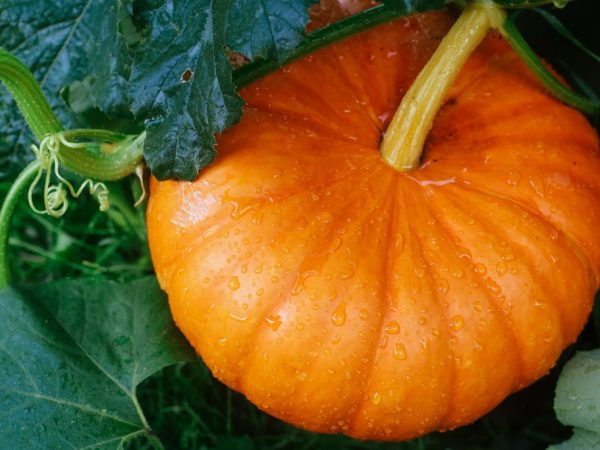
Features of growing pumpkin in the Urals
The best varieties
You can grow pumpkin crops in any area, but it is important to create optimal conditions for them. The quality and indicators of the harvest depend on this. You should choose a variety that is intended for planting in the Urals. It is necessary that it be characterized by resistance to frost. Preference should be given to early crops so that they have time to ripen before the onset of cold weather.
Pearl
This is a crop characterized by mid-early ripening. Its vegetation lasts only 100 days from the moment of planting. A feature of the Pearl variety is considered to be that it can withstand small changes in temperature and weather changes.
Pumpkin of this variety has high yields. From 3 bushes, you can collect about 5 kg of vegetables. The pumpkin is pear-shaped. The rind is thin. The pulp is juicy, tasty. Pumpkin weight is about 6 kg. The aroma of the pulp is nutmeg. This variety is ideal for long-term storage over the winter.
Bush orange
Ripens in 90 days from the moment of planting in open ground. The bushes are compact and do not braid. The fruits are round in shape and have a rich orange peel. Fruit weight - 5 kg. The pulp is sweet, tender. It contains a high concentration of carotene, which is useful for humans.
Bushy Orange Pumpkin is an early variety. The fruits grow and are ready for consumption already on the 60th day after planting. The pumpkin is characterized by a rounded, slightly flattened shape. From one pumpkin bush, you can collect about 15 kg of fruit. The pulp is a rich golden hue, like the rind. It tastes good and is a little crispy.
Dachnaya
This is the earliest variety that can only be grown in the Urals. Vegetation lasts only 50 days from the moment of planting in open ground. The unusual appearance of this variety attracts the attention of farmers. The bottom line is that the peel is characterized by a rich green tint, but it has yellow (golden in the sun) stripes.
The average weight of a ripe fruit is about 6 kg. About 15 kg of vegetables are harvested from each bush.
Sweetie
It is a culture that is resistant to even the most severe frosts. It ripens on the 75th day. The bushes are large. The shape of the pumpkin is round. The rind is a pleasant pale gold color. The pulp is sweet and tasty.
Fruit weight reaches a maximum of 2 kg. There are green stripes on the skin that divide the pumpkin into wedges.
Growing conditions
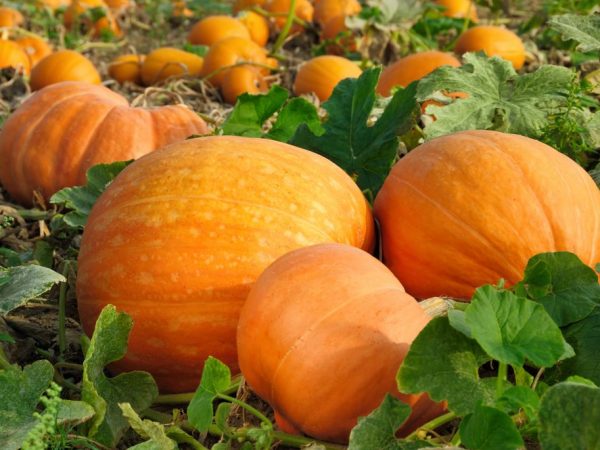
The yield of plants depends on the correct care.
If you want the grown pumpkin to be characterized not only by a pleasant taste, but also by a beautiful appearance, you need to create high-quality conditions for it.
The basic rules of crop rotation should be adhered to. You cannot plant a pumpkin in the same place all the time. Better to take a break for several years. So the soil will have time to recover. Try to plant pumpkin crops only after legumes, so you will increase yields.
It is important to provide pumpkin crops with adequate lighting. The less sunlight falls on the ovary, the less it will be formed. Lack of lighting provokes the emergence of pests that can completely destroy the garden plots.
For a pumpkin culture in the Urals, you need to choose well-lit areas, protected from drafts. Give preference to those places that are located near buildings.
Growing seedlings
In most cases, landing is carried out in 2 ways:
- using pre-grown seedlings;
- sowing seeds in open ground.
To grow a pumpkin in the Urals, you will need to use the first method. So you will protect the crop from frost and significantly increase the yield. But you need to consider both methods so that their features are clear.
Landing
Planting pumpkins in open ground in the Urals is best done in early May. If the seeds are planted in a greenhouse to obtain seedlings, then the sowing is carried out 2 weeks earlier. Before this, you need to properly prepare the planting material. Not only its resistance to pests and diseases depends on this, but also the quality of seedlings.
To begin with, select a suitable planting material. To do this, place the seeds in a container filled with water. Leave them there for a few hours. Those seeds that have appeared on the surface must be thrown away, they are empty and will not germinate.
The remaining seeds are placed in a manganese solution for half an hour. After that, they are taken out, wrapped in gauze and left on the battery to dry out and germinate. Germination is usually observed after a few days.
Because the pumpkin does not tolerate a pick, you need to choose the correct container for planting. Prefer disposable cups or those made from peat.
The soil should be nutritious and light. It can be made at home by taking 2 buckets of peat, 1 bucket of sawdust (it is better to take those that have already rotted) and 1 bucket of humus. If you do not want to prepare the soil yourself, you can buy it in special stores.
The seed planting process consists of these stages:
- fill the glasses with half-cooked soil;
- make a small hole in the ground, literally 2 cm. Place the seeds inside;
- cover the planting container with cling film to create a greenhouse effect;
- Move containers to a warm place with minimal sunlight. It is necessary to provide the planting material with optimal conditions for germination. The daytime temperature should be 20-24 ° C, and the nighttime temperature should be 13-17 ° C.
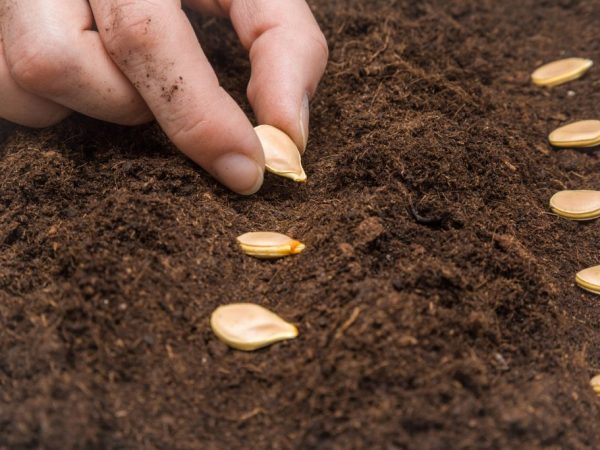
Only healthy seeds are suitable for planting
Do not allow a strong decrease or increase in temperature. This is detrimental to seedlings. The first shoots will appear in 3-4 days.
Seedling care
Proper care is the most important process when growing pumpkins in the Urals. First you need to remove the film from the glasses as soon as the first shoots appear. After a week, place the containers with seedlings in a room where the temperature will be several degrees lower. This is done so that the seedlings do not stretch out.
Otherwise, you will have to add some more earth. In order for the seedlings to grow correctly, the glasses must be placed on a well-lit windowsill. It is necessary to regularly water it with a small amount of water.
After 14 days from the moment the first shoots appear, fertilization is required. Top dressing should consist of organic or mineral substances.The best option is to use 50 mg of nitrophoska per 5 liters of water, or dissolve 200 g of mullein in 2 liters of water.
Moving seedlings into the ground
Seedlings that have good growth should be planted under a film in open ground at the end of May. If weather conditions do not allow the process to be carried out at this time (cold and sudden changes in temperature), you can postpone it for several weeks.
For transplanting into open ground, seedlings that have reached the age of one month are suitable. By this time, several leaves are already forming on them, and the height is about 12 cm. Planting should be carried out in cloudy weather. If it is clear outside the window, you can spend it in the evening. The main thing is that the sun's rays are inactive.
Planting scheme - 120 x 120 cm.
The process is carried out as follows:
- you need to make a small hole in the soil, then pour humus and ash in equal amounts on its bottom, after which all the contents are poured with warm water;
- from the glass in which the seedlings were grown, you need to get the seedling - it is best to take it out together with the earthen lump so that the roots are not damaged;
- place it upright in the hole and sprinkle it tightly with earth;
- after these procedures, mulching of seedlings is required - humus is ideal for these purposes;
- after mulching, cover the beds with foil.
Outdoor pumpkin care
Caring for a pumpkin in the Urals is not as difficult as it might seem. The process consists in regular watering, feeding and proper formation of the bush.
If you do all these procedures correctly, according to the basic recommendations, then it will not be difficult to grow high-quality vegetables. The main thing is to monitor the condition of the plant. Perhaps some of the care procedures will be unnecessary or not enough.
Watering
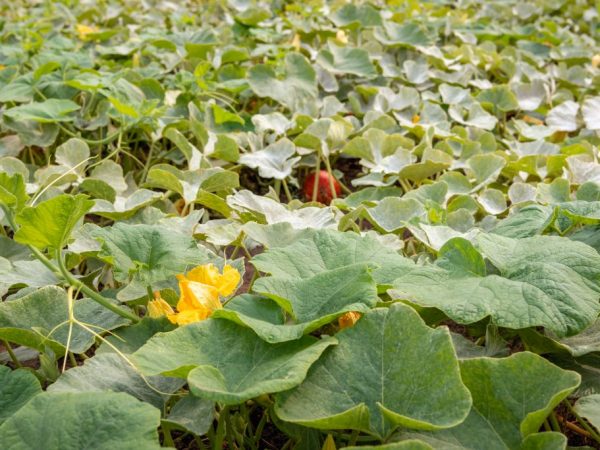
You can only water pumpkins with warm water.
Watering should always be done in conjunction with loosening the soil and removing weeds. All these procedures must be carried out carefully so as not to damage the root system of the pumpkin culture. You need to water the vegetable with extremely warm water.
Remember that the use of cold water causes stunted growth and has a detrimental effect on the condition of the roots.
You need to actively water the seedlings at the moment when the ovaries are formed. This will increase the yield. Pour at least 30 liters of water under each bush, paying special attention to the roots. Try to irrigate the crop so that moisture does not get on the leaves, otherwise they will dry out under the influence of the sun.
Watering interval is about 1 week. Remember that you cannot actively water the pumpkin when the fruits are already forming. A large amount of moisture in vegetables reduces their shelf life. They loosen the soil and remove the weeds 3 days after watering. This will provide sufficient air for the roots.
Top dressing
The fertilization interval should be 2 weeks. Frequent feeding can provoke the death of the bush. Make-ups in open ground conditions are applied twice:
- when 5 sheets have formed, you need to put 15 g of nitrophoska under each bush;
- after the lashes are formed, 20 g of nitrophoska are poured into 10 liters of warm water. 1 liter of solution is poured under each bush.
You can also use organic fertilizers for fertilizing. Under each bush, you can add 100 g of wood ash or 2 liters of mullein solution (1 kg is diluted in 10 liters of water and infused for an hour).
Fertilizers are applied not just at the root, but in special holes around the bush. Their depth should be about 10 cm. The pits should be at a distance of 20 cm from the plant.
Lash formation and pollination
The formation of lashes ensures stable growth of the bush. This helps the formation of large fruits and fills the pulp with a pleasant taste. If you grow pumpkin in the Urals, you need to leave no more than 3 ovaries on each bush.
You need to form the bushes in 2 stems. On the main one, the ovaries are removed so that only 2 are left, and only 1 ovary remains on the side. After the ovaries, 3 shoots are left.The rest need to be pinched.
If weather conditions do not allow insects to pollinate the pumpkin, you need to do it artificially. Plants need to be pollinated in the morning. For this, the male flower is leaned against the female one. If you do not know how to distinguish male from female flowers, it is not difficult to do this. Females form small ovaries, while males have a thin stem.
Diseases and pests
When a farmer grows a pumpkin, he should regularly monitor its development. If parasites or diseases appear, you need to eliminate them in time.
If it is too late to carry out treatment against pests or diseases, you can lose not only pumpkin crops, but also other plants in the garden.
Treatment of diseases
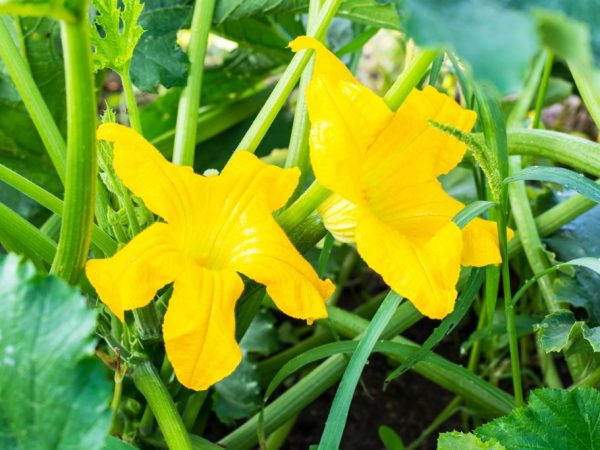
Check the plant periodically for signs of disease
The most common pumpkin disease is bacteriosis. It manifests itself in the fact that brown spots appear on the cotyledons. The pumpkin is deformed and the yield decreases.
As a prophylaxis for this disease, the seeds should be treated with zinc sulfate (2 g per 5 l of water) before planting. If the disease affects the cotyledons, the bushes are treated with Bordeaux liquid (40 g per 7 liters of water).
Often there is white rot on the pumpkin. You can determine its presence by the white bloom on the bushes. Treatment of this disease is carried out by trimming the affected areas. The cut sites are treated with copper sulfate (30 g per 3 liters of water).
If powdery mildew appears (white bloom on the leaves, which provokes their rotting), you need to treat it with colloidal sulfur (20 g per 2 l of water). When root rot appears, spraying with the "Previscur" preparation should be carried out (read the instructions carefully).
Pest control
Spider mites appear on pumpkin crops. To destroy the parasite, you need to dissolve 3 kg of onion husks in 10 liters of water and spray.
To get rid of aphids, you need to treat the culture with Karbofos (100 g per 10 l of water). If this is not done, it will completely destroy the plant. This parasite feeds on the sap of the bush, its activity leads to the drying of the leaves and stem.
Harvesting
When growing a pumpkin crop in the Urals, you need to know when to harvest.
Late harvesting is accompanied by a lot of rotten or damaged fruit. This not only affects the level of the crop, but also reduces its shelf life.
Ripeness signs
There are several main signs that will indicate ripening of vegetables:
- you can remove the pumpkin if the stalk is withered;
- dry leaves on the bushes also indicate ripeness;
- in ripe fruits, the skin is firm and firm.
When harvesting, the stalk must be cut carefully so as not to damage the peel. It is customary to leave about 3 cm of the stalk on the pumpkin.
Harvest storage
It is best to store vegetables in cool rooms (basement, garage, shed). It is required to adhere to certain rules. Store pumpkins at 5-15 ° C. Maximum air humidity - 70%.
Keep in mind that the shelf life of the pumpkin will increase if there is ventilation in the room.
Only crops that are not damaged are suitable for storage. Otherwise, there is a great risk of rotting. Make sure that the pumpkin is on wooden or metal shelves. It cannot be stored on damp earth.
Cultivation of high-quality and tasty pumpkin can be carried out even in the Urals. Despite the cold climate and sharp temperature changes, there is always the opportunity to boast of a large harvest. Only for this it is necessary to provide the pumpkin crops with the correct planting and care process.

